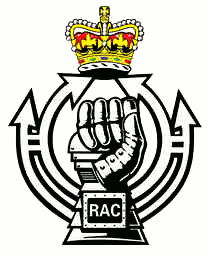
The Royal Armoured Corps is the component of the British Army, that together with the Household Cavalry provides its armour capability, with vehicles such as the Challenger 2 Tank and the Scimitar Reconnaissance Vehicle. It includes most of the Army's armoured regiments, both the Royal Tank Regiment and those converted from old horse cavalry regiments. Today it comprises twelve regiments, eight regular and four reserve. Although the Household Cavalry Regiment provide an armoured regiment, they are not part of the RAC.
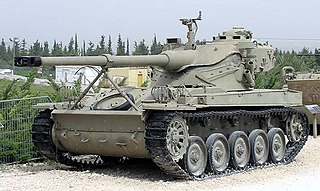
The AMX-13 is a French light tank produced from 1952 to 1987. It served with the French Army, as the Char 13t-75 Modèle 51, and was exported to more than 26 other nations. Named after its initial weight of 13 tonnes, and featuring a tough and reliable chassis, it was fitted with an oscillating turret built by GIAT Industries with revolver type magazines, which were also used on the Austrian SK-105 Kürassier. Including prototypes and export versions, over a hundred variants exist, including self-propelled guns, anti-aircraft systems, APCs, and ATGM versions.

The Singapore Army is the land service branch of the Singapore Armed Forces (SAF). It is the largest of the three services and primarily a conscript army that in the event of national exigencies or war, morphs itself from peacetime to a war footing by mobilising almost all of its combined combat power by calling up operationally-ready military reservists.

The Land Component is the land branch of the Belgian Armed Forces. The King of the Belgians is the commander in chief. The current chief of staff of the Land Component is Major-General Pierre Gérard.

Panzergrenadier, abbreviated as PzG (WWII) or PzGren (modern), meaning "Armour"-ed fighting vehicle "Grenadier", is a German term for mechanized infantry units of armoured forces who fight from and in conjunction with infantry fighting vehicles (IFVs) – that is, infantry transported in and fighting alongside combat vehicles specialized for such tasks. Fighting is conducted either from within the vehicle or alongside it.

The King's Own Calgary Regiment (RCAC),, is a Canadian Army armoured reconnaissance regiment of the Canadian Armed Forces Primary Reserve. Headquartered at the Mewata Armoury in Calgary, Alberta, the KOCR is a part-time reserve unit of 3rd Canadian Division's 41 Canadian Brigade Group. Its regimental museum is located in Calgary.
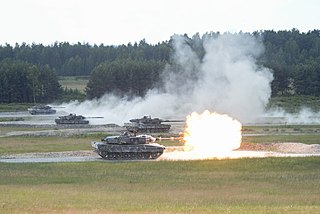
Armoured warfare or armored warfare, is the use of armored fighting vehicles in modern warfare. It is a major component of modern methods of war. The premise of armoured warfare rests on the ability of troops to penetrate conventional defensive lines through use of manoeuvre by armoured units.

The Royal Canadian Armoured Corps is the armoured corps within the Canadian Army, including 3 Regular and 18 Reserve Force regiments as well as the Royal Canadian Armoured Corps School.

1st Armoured Regiment is an armoured regiment of the Australian Army and is the senior regiment of the Royal Australian Armoured Corps. Formed as a tank unit in the new Australian Regular Army on 7 July 1949, the regiment subsequently saw service during the Vietnam War operating Centurion tanks. Currently the unit is based in Edinburgh, South Australia as part of the 1st Brigade. As part of the Plan Beersheba reorganisation, the unit has become one of three Armoured Cavalry Regiments (ACRs) assigned to the Army's multirole combat brigades in Brisbane, Darwin and Townsville. Each ACR is equipped with M1A1 tanks and ASLAV light armoured vehicles.

The Bionix (BX) is a family of tracked Singaporean armoured fighting vehicles developed by Singapore Technologies Kinetics. Intended to augment the Singapore Army's aging M113 armoured personnel carriers, it is the first indigenous armoured vehicle to be developed in Southeast Asia. The Bionix has been operational with the Singapore Armed Forces (SAF) since 1999 in a wide variety of adaptations including the Bionix II, Bionix 25 and Bionix 40/50 variants.

The Renault R35, an abbreviation of Char léger Modèle 1935 R or R 35, was a French light infantry tank of the Second World War.
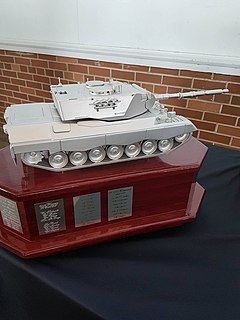
The Worthington Trophy is a Canadian military award. It was awarded annually to the best reserve armoured unit in the Canadian Land Forces. It is named after Major-General F. F. Worthington, known as Fighting Frank – "The Father of the Royal Canadian Armoured Corps".
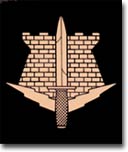
The Singapore Combat Engineers (SCE) is a formation of the Singapore Army. Combat Engineers provide mobility by bridging gaps and clearing minefields to facilitate speedy advance of troops into enemy territory, and counter-mobility by constructing obstacles such as anti-tank ditches to impede the enemy's movement. The Combat Engineers also construct trenches, drainage systems and other related infrastructure to enhance the survivability of troops during operations.

1 Special Service Battalion is an armoured regiment of the South African Army and only one of two such in its regular force. The Regiment is based at Tempe near Bloemfontein.

An armoured vehicle-launched bridge (AVLB) is a combat support vehicle, sometimes regarded as a subtype of military engineering vehicle, designed to assist militaries in rapidly deploying tanks and other armoured fighting vehicles across gap-type obstacles, such as rivers. The AVLB is usually a tracked vehicle converted from a tank chassis to carry a folding metal bridge instead of weapons. The AVLB's job is to allow armoured or infantry units to cross craters, anti-tank ditches, blown bridges, railroad cuts, canals, rivers and ravines), when a river too deep for vehicles to wade through is reached, and no bridge is conveniently located.
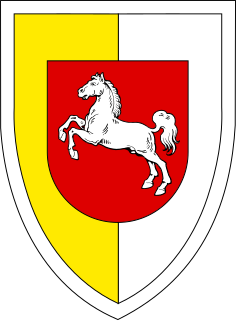
The 9th Panzerlehr Brigade is a formation of about 5,000 men strong within the German Armed Forces or Bundeswehr, which is subordinated to the 1st Panzer Division in Hanover. The bulk of the brigade is stationed in Munster. Two battalions are based in Neustadt am Rübenberge. The brigade has become the "showcase of the German Army" as a result of its German Army Combat Vehicle and Aircraft Demonstration Exercises which it has conducted for decades. These exercises demonstrate the capability of the Army's fighting vehicles and aircraft and how they operate jointly in various scenarios. The formation is classified as an armoured brigade within the Bundeswehr's intervention forces.
The 42nd Battalion, Singapore Armoured Regiment is one of the 4 armoured infantry battalions of the Singapore Army.

French development into tanks began during World War I as an effort to overcome the stalemate of trench warfare, and largely at the initiative of the manufacturers. The Schneider CA1 was the first tank produced by France, and 400 units were built. The French also experimented with various tank designs, such as the Frot-Laffly landship, Boirault machine and Souain experiment. Another 400 Saint-Chamond tanks were manufactured from April 1917 to July 1918 but they were underpowered and were of limited utility because the caterpillar tracks were too short for the tank's length and weight. The most significant French tank development during the war was the Renault FT light tank, which set the general layout for future tank designs and was used or redesigned by various military forces, including those of the United States.
The following lists German active and reserve units within the structure of the German Army. Reserve units do not possess any heavy equipment and their personnel is intended as replacements for losses sustained by regular units.

































